‘Knowledge is at the heart of social and economic growth. Knowledge relies heavily on shared cultural heritage and on openness to the unknown. To that end, artists have a special role as social barometers, as promoters of change and as repository of tradition…’
(Marina Galvani, Tanzania Knowledge is at the heart of development — A letter from the head curator of the World Bank art program to the National Arts Council)
They say ‘a journey of a thousand miles begin with a single step’. The initiative to rescue a piece of Tanzania’s cultural heritage, the late George Lilanga’s stucco portico and Shetani gates that graced the entrance to Nyumba ya Sanaa (Swahili for ‘House of Art’), is evidence for one of the many first steps that the Tanzanian public seem to (of late) be taking towards its journey to a cultural awakening.
Until very recently, and despite its attempt to develop a comprehensive cultural policy (Sera ya Utamaduni — 1997) with specific strategies for art promotion (visual art included), Tanzania remained one of the least developed visual art scenes amongst developing countries with a rather rudimentary sense of art appreciation. Tanzanian art and artists have also been, generally, the least (re)presented in major hubs for contemporary art—like art biennales, major exhibitions, art fairs, etc. — internationally and including the ones that take place on the continent. This ‘underperformance’ in the field is, arguably, one of the manifestations of the extent to which there is a gap between the Cultural Policy as a ‘statement of intent’ and its implementation and a reflection of the fact that the great majority of creative and cultural productions in Tanzania had for the longest time taken place in an environment in which there is little or no coherent strategy for investment in education and training.
Visual art has for the longest time been, to most Tanzanians, considered as a craft — a mere hobby that just about anyone could learn. And not surprising, considering the fact that it is not until university level that art is (seriously) taught as a subject—in lower levels, elements of art skills are integrated in vocational skills subject, which teachers complain they have no skills to teach and therefore chances for a few gifted children with parents who appreciate art happen in a few circles and outside the schools. It is, perhaps, for this reason that there had been an absence of the necessary policies that would secure the art sector, and its development, as beneficial and sustainable activity.
We artists occupy a very peculiar place in class structure — I include myself in this ‘we’ here because I am too working from within the country both as a visual artist and as the artistic manager responsible for designing and running most of Nafasi Art Space programs — the only existing contemporary art space in the country. Working with our hands and consuming a great amount of time and materials creating objects, we are laborers… laborers to a culture whose community we some day hope to see evolve to love and appreciate art. The discomfort that I, as Tanzanian artist, associate with laboring for my art somehow gets pushed further and further away and the labor starts to feel more worth it when I see Tanzanian art beginning to gain recognition as our society starts to appreciate art more and more these days. This could, perhaps, be a result of the exposure brought about by projects and events initiated and/or supported by spaces like Alliance Française, Goethe Institute Tanzania, and the likes; as well as personal initiatives that provide workshops, trainings, exchanges, exhibitions and other public involving events and activities offered by art practitioners and professionals through various NGOs and arts networks – the likes of Nafasi Art Space.
Long before any of these initiatives ever existed, the late ‘Baba wa Taifa’ (Father of the Nation) Mwl. Julius Kambarage Nyerere established Nyumba ya Sanaa in 1974, positioning it in the middle of Dar es Salaam to ensure sustainability of art, and to create opportunities for artists to produce and survive on their own. He believed that if it could be efficiently utilized, it would reduce the artists’ begging syndrome to donors and the state, which enslaves them. Nyumba ya Sanaa was for the longest time, the leading center for art in Dar es Salaam and was responsible for some very big names in Tanzanian visual art like Robino Ntila, Augustino Malaba, Francis Imanjama, Evarist Chikawe… just to mention a few.
The late George Lilanga, one of the most famous and internationally acclaimed Tanzanian artists, a visual art giant in his own right, began his career at Nyumba ya Sanaa and went on to become a major representatives in the field to the point where his paintings and sculptures are often featured on the cover of many reference books dealing with the subject. His works have travelled the world and even form a part of several museums and private permanent collection (e.g. the Jean Pigozzi collection). He was an all rounded artist who succeeded in using a distinctive traditional imaginary and, by bringing in his own visual language in the creation of his works, making of it an art of universal appeal. His sculptures, reliefs and paintings have been the (un)conscious inspiration for many artists in the world and mostly in Europe — as many would attribute to African traditional art as inspiration for the modernist movement with Picasso and Cezanne, Lilanga is an icon, representing Tanzania, of the kind of creativity and originality that sparks from Africa to ignite the world.
It is quite unfortunate and rather saddening that after his death and, later, the demolition and relocation of Nyumba ya Sanaa to its new premises where it largely suspended its role as a cultural center, the late Lilanga’s stucco portico and Shetani gates that he created for the entrance to (and as face of) Nyumba ya Sanaa — one of the emblematic symbols of Dar es Salaam and the only venture of the artist into monumental/mural art—had been dismantled and was in danger of being destroyed. At the moment, this unique heritage has been catalogued and is being preserved at the National House of Culture. This is after some of it was removed from the new Nyumba ya Sanaa premise and the rest of it was rescued from the port just as it was about to get shipped off to Germany after being sold off for 50USD per piece under Nyumba ya Sanaa’s authority. Efforts are now under way to preserve the portico as a centerpiece of a living cultural space, to be restored within the National House of Culture.
The National House of Culture is alleged to, at the moment, be facing a resource crunch to an extent that it is forced to overcharge the rate for its exhibition halls so much that most artists are not even able to afford showing their works there and to rent out some of its acreage to weddings and other non-art related events. With this harsh reality, there is no telling what the fate of this unique heritage will be, but, through public mobilization there has, so far, been willingness for collaboration and support (financial and otherwise) from a number of Tanzanian creatives, public and private organizations to ensure that plans are underway for the National House of Culture to transform the museum’s inner courtyard into a Lilanga courtyard—a space for art education and creative exchanges. This will not only raise the late Lilanga’s profile and legacy (which seems to be carried with the highest regard everywhere else but not so much in his own country) in particular, but also modern and contemporary Tanzanian art in general. More and more people are showing interest to fundraise and join hands to show how much this cultural heritage deserves to be cherished and protected as a way to support knowledge creation and preservation.
In many countries, the development and success in the visual art field is partly made possibly by support from the government, but largely carried by supporters, sponsors, collectors, etc. from within the community itself. As a Tanzanian artist, I find the fact that the Tanzanian public is beginning to care for the fate of visual art (as demonstrated by this initiative) and are beginning to front row in the steering of the development of the sector very encouraging. It is evidence that Tanzania is at the dawn of a ‘cultural awakening’. How long this ‘awakening’ will continue to spread is debatable, but the feeling so far is that there is no going back. The genie, finally, is out of the bottle!
Image credits:
- George Lilanga: Watoto wanacheza katika kiwanya cha michezo mbali mbali, 1987 [source]
- The original Nyumba Ya Sanaa: Wikipedia [source]
- Moving of George Lilanga’s work: Maria Amelina
Related links:


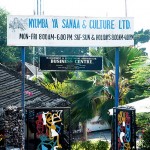
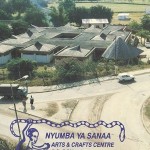
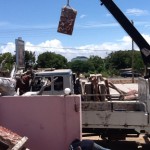
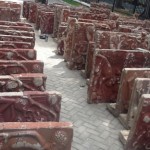

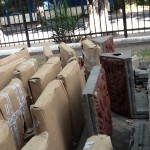
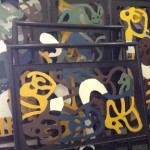
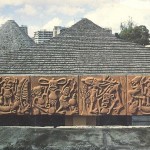
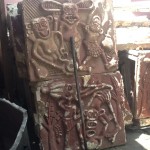

Knowledge is important. But better than imaginings and fake are truth and reality. Here is an example: In the autumn 2010 started the demolition of the former Dar es Salaam art house Nyumba ya Sanaa (NYS) in order to build a bank-building on that plot. After the NYS-building was torn down the concrete roof-edge-slabs (also called frieze plates or fresco panels or stucco portico) and metal gates that were drafted by George Lilanga 1982 for this building were stored outside at a garbage place. Since the demolition plans became known, besides the Hamburg Mawingu Collection (HMC) nobody in Tanzania or elsewhere was interested in that works of Lilanga. After nearly two years in summer 2012 the HMC finally was successful to acquire a series of roof plates and the metal gates and to save them from the loss and destruction. Because the items were in very bad condition by order of the HMC they were restored by a Dar es Salaam Fundi workshop in a lavish way. The aim of this rescue operation was to establish a supporting project for talented Tanzanian visual artists in the sense of George Lilanga to give them working possibilities, international exhibition space, recognition and praise. We offered cooperation to the Tanzanian Ministry of Culture and BASATA. But there was absolutely no interest. Why?
More information on internet:
http://georgelilanga.blogspot.com/
http://www.pinterest.com/hamburgmawingu/pins/
http://pictify.com/user/HMCLilangaCollection/george-lilanga
http://www.lilanga.info
Did you try going to the public for support? Also when you say acquire, I’m curious to know who was on the receiving end for royalties – the artist’s estate or the city?
This is really good article for real, bringing awareness to masses notably to reveal the works of legendary, Basically i have been asked a lot for the reason why Nyumba ya sanaa demolished, I feel ashamed for that (cause i work as guide to show people around) and mostly of clients keen to see Nyumba ya Sanaa(unfortunately isn’t there anymore), due to Lilanga works to be recognized and cherished in other parts of the world instead of his home territory. I’m really looking forward to attend at the Exhibition with some folks adhere to spread a word to others about this.
I really appreciate this article
KUDOS
Thanks for stopping by, January. What about providing tours of digital galleries?
HMC Hamburg Mawingu Collection… what is it that you are asking or commenting on? (with regards to this piece)… i don’t quite understand this comment.. are you trying to educate us, and open our eyes to the ‘truth’ that is: HMC was the one responsible for the rescue of Lialanga’s work and not the parties mentioned in the article?.. and if this is your argument, then for whom was HMC rescuing the works?… From my understanding, and i could be wrong, HMC’s efforts to rescue these works were so that they could open a Lilanga ‘Tanzanian Art’ house/museum in Hamburg, Germany (and i understand this ART was not just limited to Lilanga’s… a lot of Makonde sculptures, old Lilanga and Tinga Tinga paintings, etc were/are being acquired for this collection too)… How was Tanzania to benefit from all this? I don’t understand how one country’s cultural heritage gets rescues and restored to be preserved in a different country where its people would have little (or no rather) access to the heritage!
And once HMC got no cooperation from the ministry and BASATA… were there any further efforts made to mobilize public support for the restoration of Lilanga’s works in his own country? (because as far as i know, the locals have been and are still very supportive of the ongoing efforts to have the Lilanga courtyard at the national museum.. and all the educational and art and culture awareness programs, artist exchanges, etc that would come as a result of this project)… we are guilty of being a community with little or no awareness, exposure, and knowledge of the happenings when it comes to art and culture in the country, yes, but we are not all completely disinterested with the fate of our heritage… if you seek support, you will get support… especially for something this important!
Lets also discuss royalties… who gets royalties for all the art stolen/acquired/restored/taken (not even sure which word applies here) from Tanzania by HMC
And then we come to this whole (so tiring) issue of the center and the periphery.. who exactly decides that international praise and recognition matters more than praise and recognition from within one’s own country? and who says that our artists can not get working possibilities, and opportunities to exhibit in international exhibition spaces from within their own country?… I base my art practice from here and i have had no problems getting work opportunities or exhibition opportunities locally and international (not to say it has been an easy ride… but then again, where in the world has being an artist ever been easy??)…
I think praise and recognition matters more at home… If there are more people who think like HMC (that praise and recognition needs to come from the west), then there is maybe more need to bring awareness to our community and our artists of the fact that African contemporary art is booming… we no longer (if ever we felt the need) have to kiss up to the west to make it;
http://www.cnn.com/2014/07/16/…/africas-contemporary-art-is-booming-grab/
http://www.economist.com/blogs/baobab/2014/05/africas-booming-contemporary-art-scene
http://www.theguardian.com/artanddesign/2013/jul/10/africa-art-value
I think its also time for Africa’s stolen artifacts to come home… #BRINGBACKOURART (yes, you too HMC);
http://thinkafricapress.com/history/time-to-return-africa-stolen-artifacts
I have closed my comment with a question. You wrote many words but you didn’t give a convincing answer. Let me ask more questions:You call it theft that an art collector buys art work directly from the hand of the artist? You really demand back these works? You demand royalties for what? That the artist is glad an gave his permission that his sold and paid works were shown worldwide by a 100 % non-commercial art collection on internet, with books, at exhibitions ect. and the artists reputation grow up?You call it theft when the former Nyumba ya Sanaa did sales exhibitions with works from Lilanga, Ntila, Malaba, Imanjema etc. and sold the works to foreign collectors, art lovers, tourists etc.? You really demand back these works because they are “cultural heritage”?You call it theft that Tanzanian art dealer bought sculptures, paintings etc. from artists like Makonde in order by international art dealer so that the artists were able to feed themselves and their families and can continue their art work for long time?In my opinion your suggestion of “cultural heritage” regarding contemporary art and artists is like the view on a graveyard. It seems to me that you would like to have an “art reservation” with standstill. I have no need to educate you and I never did this. You have your opinion and I have mine. But in my view it makes no sense to ignore the wishes of contemporary visual artists who wants to show their ability to the audience. You should ask the Tanzanian artists who had the possibility to visit foreign countries about their experiences and benefit. This is the place where we work. You may work at another place. OK, everybody where one belongs to.Finally: This evening we celebrated the opening of the Week of Partnership Hamburg – Dar es Salaam (twin towns since 2010) under the title Celebration Friendship. The event was held in Hamburg City Hall and the special guests were the mayor of Dar es Salaam and his delegation. This was an important event. But we missed Tanzanian visual artists. One of the aims of my project (beside a lot of others) is to change this situation. And I think: yes, we can! You are invited to change your critical point of view regarding “cultural heritage” in this case and support the project. Therefore I ask: SET MY ITEMS FREE!
It burns that NYS is no more and that we cannot go to enjoy those Lilanga works anymore. Art isn’t art because it feeds stomachs (as a side effect, stomach-feeding is great). Perhaps art is art because it feeds the imagination.
On the spot that Nyumba ya Sanaa stood now stands NMB Bank Headquarters. Where is Nyumba ya Sanaa relocated? I did not hear any protests from the artists when that facility was being torn down. Or was there any?